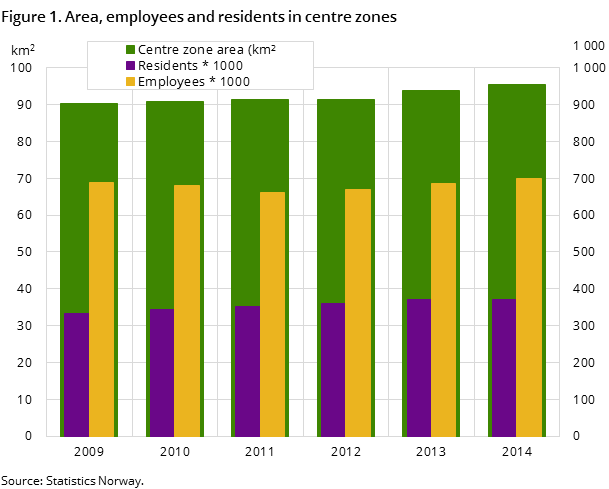Content
Published:
This is an archived release.
More people living in centre zones
The number of residents in centre zones has increased in the last five years, and the number of employees has also increased somewhat. The density of residents has shown a weak increase, while the density of employees on the other hand has shown a weak decrease.
| 2014 | 2009 - 2014 | ||
|---|---|---|---|
| Area of centre zones (km²) | Residents per square kilometre | Residents per square kilometre | |
| The whole country | 95.5 | 3 887 | 5 |
| Urban settlements with 200 - 1 999 residents | 5.3 | 1 008 | -2 |
| Urban settlements with 2 000 - 19 999 residents | 34.6 | 1 714 | 10 |
| Urban settlements with at least 20 000 residents | 55.2 | 5 553 | 4 |


People are increasingly choosing to live in urban areas. There is also a political goal to utilise the urban areas as well as possible in order to ease the pressure on the surrounding land whilst also minimising the need for transport.
Live somewhat denser
The number of employees in centre zones has increased from 2009 to 2014. The number of residents has also increased, but by somewhat more (11 per cent). In comparison, the number of residents in the country as a whole has increased by 6.5 per cent over the same period.
Centre zones have around twice as many employees as residents.
There are around 4 000 residents per km2 in centre zones. While the number of residents has increased, the density has only shown a weak increase. This is due to an increase in the centre zone area. The employee density has correspondingly had a weak decrease from 2009 to 2014.
High density of residents is an indicator of effective land use utilisation as well as less energy-intensive transportation. High density of residents can, on the other hand, indicate poor dwelling conditions, scarcity and pressure on green areas.
Additional information
This statistics monitor the development in centre zones in relation to residents, employees and density. Based on automatic delimitation of the centre zones.
Contact
-
Erik Engelien
E-mail: erik.engelien@ssb.no
tel.: (+47) 91 12 55 45
-
Jørn Kristian Undelstvedt
E-mail: jorn.kristian.undelstvedt@ssb.no
tel.: (+47) 94 50 68 64
